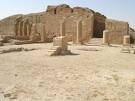 Dura-Europos ("Fort Europos") was a Hellenistic and Roman walled city built on an escarpment ninety meters above the right bank of the Euphrates river. It is located near the village of Salhiyé, in today's Syria (34°44.82′N, 40°43.85′E).
Dura-Europos ("Fort Europos") was a Hellenistic and Roman walled city built on an escarpment ninety meters above the right bank of the Euphrates river. It is located near the village of Salhiyé, in today's Syria (34°44.82′N, 40°43.85′E).
It was founded in 303 BC by the Seleucids on the intersection of an east-west trade route and the trade route along the Euphrates. The new city, commemorating the birthplace of Alexander's successor Seleucus I Nicator, controlled the river crossing on the route between his newly founded cities of Antioch and Seleucia on the Tigris. Its rebuilding as a great city built after the Hippodamian model, with rectangular blocks defined by cross-streets ranged round a large central agora, was formally laid out in the 2nd century BC. The traditional view of Dura-Europos as a great caravan city is becoming nuanced by the discoveries of locally made manufactures and traces of close ties with Palmyra (James).
 During the later second century BC it came under Parthian control and in the first century BC, it served as a frontier fortress of the Arsacid Parthian Empire, with a multicultural population, as inscriptions in Greek, Latin, Aramaic, Hebrew, Syriac, Hatrian, Palmyrenean, Middle Persian and Safaitic Pahlavi testify. It was captured by the Romans in 165 and abandoned after a Sassanian siege in 256-257. After it was abandoned, it was covered by sand and mud and disappeared from sight.
During the later second century BC it came under Parthian control and in the first century BC, it served as a frontier fortress of the Arsacid Parthian Empire, with a multicultural population, as inscriptions in Greek, Latin, Aramaic, Hebrew, Syriac, Hatrian, Palmyrenean, Middle Persian and Safaitic Pahlavi testify. It was captured by the Romans in 165 and abandoned after a Sassanian siege in 256-257. After it was abandoned, it was covered by sand and mud and disappeared from sight.
 Dura-Europos was a cosmopolitan society, controlled by a tolerant Macedonian aristocracy descended from the original settlers. In the course of its excavation, over a hundred parchment and papyrus fragments and many inscriptions have revealed texts in Greek and Latin (the latter including a sator square), Palmyrenean, Hebrew, Hatrian, Safaitic, and Pahlavi. The excavations revealed temples to Greek, Roman and Palmyrene gods. There were mithraea, as one would expect in a military city.
Dura-Europos was a cosmopolitan society, controlled by a tolerant Macedonian aristocracy descended from the original settlers. In the course of its excavation, over a hundred parchment and papyrus fragments and many inscriptions have revealed texts in Greek and Latin (the latter including a sator square), Palmyrenean, Hebrew, Hatrian, Safaitic, and Pahlavi. The excavations revealed temples to Greek, Roman and Palmyrene gods. There were mithraea, as one would expect in a military city.


